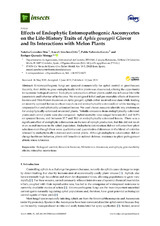Effects of Endophytic Entomopathogenic Ascomycetes on the Life-History Traits of Aphis gossypii Glover and Its Interactions with Melon Plants
Autor
González Mas, Natalia
Sánchez-Ortiz, Araceli
Valverde García, Pablo
Quesada-Moraga, Enrique
Editor
MDPIFecha
2019Materia
Biological controlBeauveria bassiana
Metarhizium brunneum
Endophyte
Pre-mortality effects
Tritrophic interactions
METS:
Mostrar el registro METSPREMIS:
Mostrar el registro PREMISMetadatos
Mostrar el registro completo del ítemResumen
Entomopathogenic fungi are sprayed commercially for aphid control in greenhouses. Recently, their ability to grow endophytically within plants was discovered, offering the opportunity for systemic biological control. Endophytic colonization of host plants could also influence life-table parameters and behavior of herbivores. We investigated lethal and pre-mortality effects of Beauveria bassiana and Metarhizium brunneum on Aphis gossypii; aphids either received inoculum while feeding on recently sprayed leaves (surface inoculum and endophytically-colonized) or while feeding on unsprayed but endophytically-colonized leaves. We used choice assays to identify any preferences for endophytically-colonized or control plants. Volatile emissions from endophytically-colonized plants and control plants were also compared. Aphid mortality rates ranged between 48.2 and 56.9% on sprayed leaves, and between 37.7 and 50.0 on endophytically-colonized leaves. There was a significant effect of endophytic colonization on the rate of nymph production, but this did not result in an overall increase in the aphid population. Endophytic colonization did not influence host-plant selection even though there were qualitative and quantitative differences in the blend of volatiles released by endophytically-colonized and control plants. Although endophytic colonization did not change herbivore behavior, plants still benefit via indirect defense, resistance to plant pathogens or abiotic stress tolerance.

